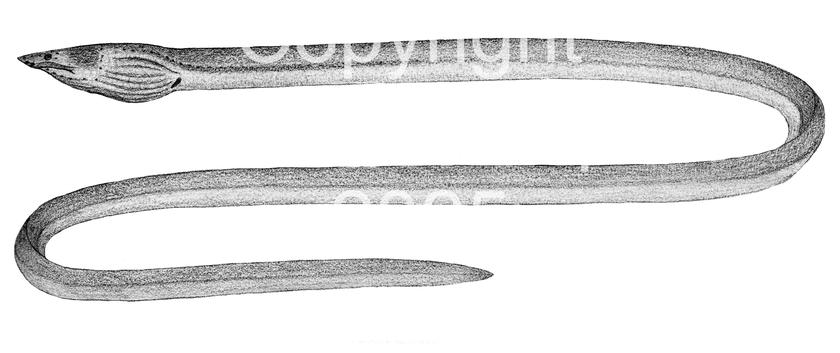
Common Name
Surf Eel
Year Described
Evermann & Marsh, 1900
Identification
Vertebrae: 125-139
Body elongate and cylindrical in cross-section. Trunk shorter than tail (36-38% TL). Snout strongly pointed and overhangs jaw. Underside of snout flattened with a toothed (5-7 teeth) median groove reaching anterior nostril. Anterior nostril a simple hole on underside of snout. Posterior nostril opens inside mouth. Eye tiny and towards tip of snout. Jaw downturned. Teeth small and uniserial. Maxillary teeth 24-30. Dentary teeth 24-30. Vomerine teeth 19 in two rows. Intermaxillary teeth present. Gill pouch strongly grooved. Gill openings low on body and strongly converging anteriorly. Dorsal and anal fins absent. Pectoral and caudal fins absent. Tail tip hard and pointed. Lateral line complete.
Color
Body sand brown with a peppering of fine dots. A triangular brown patch behind eye. Skin grooves darker.
Size
Maximum size to 47.9cm TL.
Habitat
Shallow coastal water on sand bottoms (5-15m).
Range
S. Florida to Brazil, including the Gulf of Mexico, Caribbean Sea and Bermuda.
References
McEachran, J. D. & J. D. Fechhelm. 1998. Fishes of the Gulf of Mexico. Volume 1: Myxiniformes to Gasterosteiformes. Univ. of Texas Press, Austin. 1-1112.
McCosker, J.E. & Y. Hibino. 2015. A review of the finless snake eels of the genus Apterichtus (Anguilliformes: Ophichthidae), with the description of five new species. Zootaxa 3941(1):49-78.
Other Notes
The only other entirely finless eels in the region are Apterichtus spp. which have tubular anterior nostrils and rear nostrils which open outside the mouth.